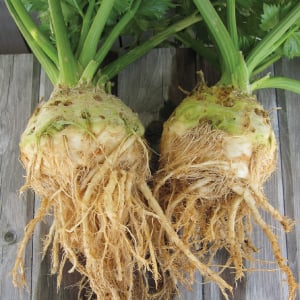
Learning Download: how to Grow Celeriac
From Seed to Harvest: A beginner’s guide to growing Celeriac.
Celeriac is a variety of celery which also is called turnip-root celery, celery root or knob celery. It typically isn’t sold as a seedling in garden centers, so the only way you’ll be able to grow the vegetable is from seed. Celeriac is harvested for its edible stem and roots. It can be eaten raw, mashed or roasted. It tastes like a cross between fennel, celery and aniseed.
To plant:
Although celeriac isn’t difficult to grow, it does require a relatively long growing season at 120 days. Also, it isn’t typically sold as a seedling or transplant, so the key is t plant these seeds inside early to get a head start on the growing season. Plant the seeds in a compost-filled seed tray and keep it indoors. Seeds can be planted indoors as early as 10 weeks before the last frost date. Don’t cover the seeds, because they require light to germinate. Celeriac sometimes doesn’t always germinate, so place a few seeds in each seed tray when planting. It can take up to three weeks to germinate, so don’t be surprised if you don’t see seedlings sprout immediately.
To grow:
Seedlings should be able to survive a transplant outside in late May or early June. When transplanting outside, make sure you plant in heavy soil. The seedlings should be hardened off before they are transplanted outside, a process that can take up to a week or 10 days. Gradually increase the celeriac’s time outside each day until it can spend a whole day outside. Celeriac enjoys moist soil conditions and will require consistent watering, especially during dry periods in the summer. Space the seedlings about 12 inches apart in rows set 12 inches apart as well. The root systems will require plenty of space. When weeding or hoeing around the plant, be careful because the celeriac’s root system is shallow and the bulbs can easily be damaged. By removing the outer leaves of the plant, it encourages the bulb to continue to develop.
To harvest:
Celeriac is typically ready to harvest around October or afterwards. Use a knife or a spade to lift the bulb from the ground because the celeriac’s root system is compiled in a tight mass which will need to be severed from the stem when harvested. If you are storing prior to consuming, don’t get rid of all the dirt from the roots because some dirt will help prevent the roots from drying out.
What celeriac craves:
Celeriac does well when treated with a top dressing of seaweed and poultry manure pellets during the summer.
Where to buy celeriac seeds:
You can find celeriac seeds at Urban Farmer.

